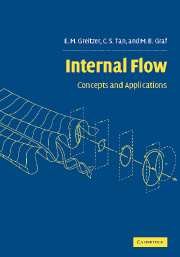Book contents
- Frontmatter
- Contents
- Preface
- Acknowledgements
- Conventions and nomenclature
- 1 Equations of motion
- 2 Some useful basic ideas
- 3 Vorticity and circulation
- 4 Boundary layers and free shear layers
- 5 Loss sources and loss accounting
- 6 Unsteady flow
- 7 Flow in rotating passages
- 8 Swirling flow
- 9 Generation of streamwise vorticity and three-dimensional flow
- 10 Compressible internal flow
- 11 Flow with heat addition
- 12 Non-uniform flow in fluid components
- References
- Supplementary references appearing in figures
- Index
5 - Loss sources and loss accounting
Published online by Cambridge University Press: 14 January 2010
- Frontmatter
- Contents
- Preface
- Acknowledgements
- Conventions and nomenclature
- 1 Equations of motion
- 2 Some useful basic ideas
- 3 Vorticity and circulation
- 4 Boundary layers and free shear layers
- 5 Loss sources and loss accounting
- 6 Unsteady flow
- 7 Flow in rotating passages
- 8 Swirling flow
- 9 Generation of streamwise vorticity and three-dimensional flow
- 10 Compressible internal flow
- 11 Flow with heat addition
- 12 Non-uniform flow in fluid components
- References
- Supplementary references appearing in figures
- Index
Summary
Introduction
Efficiency can be the most important parameter for many fluid machines and characterizing the losses which determine the efficiency is a critical aspect in the analysis of these devices. This chapter describes basic mechanisms for loss creation in fluid flows, defines the different measures developed for assessing loss, and examines their applicability in various situations.
In external aerodynamics, drag on an aircraft or vehicle is most frequently the measure of performance loss. The product of drag and forward velocity represents the power that has to be supplied to drive the vehicle. Defining drag, however, requires defining the direction in which it acts and determining the power expended requires specification of an appropriate velocity. The choice of direction is clear for most external flows but it is less evident in internal flows. Within gas turbine engines, for example, there are situations in which viscous forces can be nearly perpendicular to the mean stream direction or in which the mean stream direction changes by as much as 180°, as in a reverse flow combustor. There is also some ambiguity in the choice of an appropriate reference velocity for power input, even in simple internal flow configurations such as nozzles or diffusers where the velocity changes from inlet to outlet.
Because of this, the most useful indicator of performance loss and inefficiency in internal flows is the entropy generated due to irreversibility. The arguments that underpin this statement are presented in the first part of the chapter to illustrate quantitatively the connection between entropy rise andwork lost through an irreversible process.
- Type
- Chapter
- Information
- Internal FlowConcepts and Applications, pp. 217 - 278Publisher: Cambridge University PressPrint publication year: 2004



